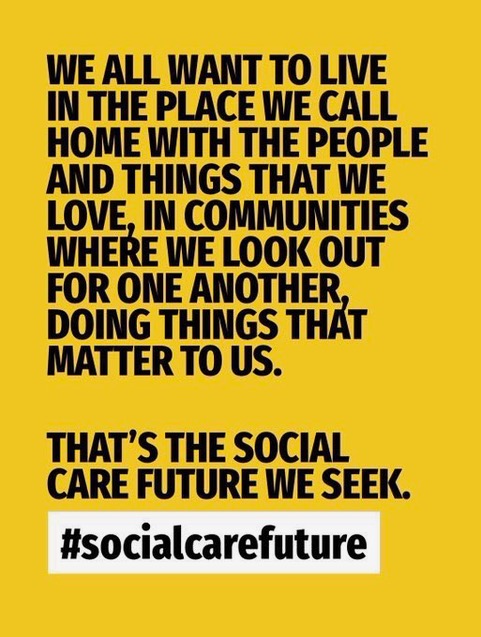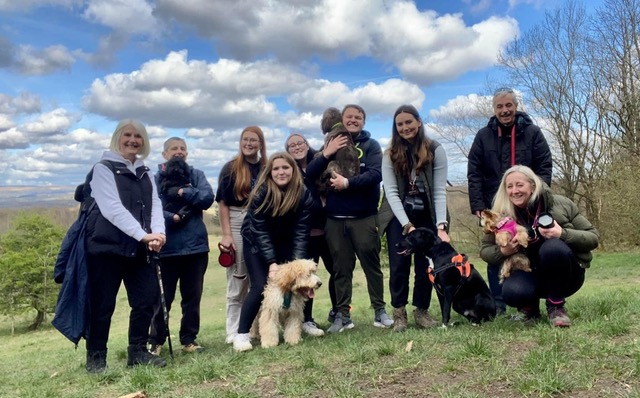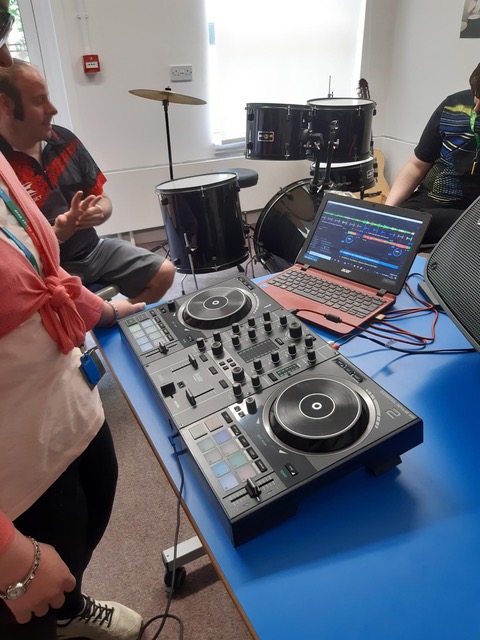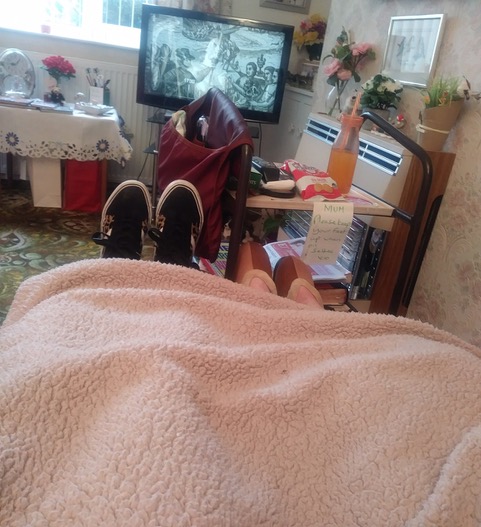Community Circles work with people to identify what they would like to do, and then together they plan how to make it happen. May wanted to sing again, and before too long, she had become a key member of the Community Choir.
Meet May
May’s first circle meeting was held in the residential home that she lives in. Her bedroom in the care home is big enough for both her floral chair and two temporary fold-up chairs for Gill and Helen. Her daughter Mandy perched on the bed. The idea of any kind of formal meeting makes May anxious. Clearly May’s circle wanted to avoid this, so to anyone else, her circle meeting looked like friends visiting and chatting.
Within the Community Circles process, this is the meeting where another facilitator, in this situation Gill, supports the new circle by using a person-centred process, and in this case, a person-centred review. Naturally the person-centred review needed to be done in a way that works for May – just focused conversation, going at her pace, but naturally, informally weaving in the criteria that need to be addressed in a person-centred review.
When Gill started talking with May about what was going well for her, May explained how she went to church at St James’ every Sunday, and happily walked there. Out of the corner of her eye, Gill saw Mandy gently shake her head. The last time May went to church was a month ago. This care home, Bruce Lodge, enables people to have two hours a month to be supported by a staff member of their choice to go out and do something that matters to them. May uses her time to go to church, but can only get there once a month. Gill didn’t challenge May’s reality. The conversation turns to drinking wine (May loves a dry white, and has one most nights), singing (May used to be in a choir and enjoys a good sing) and gliding (something that she used to do and would love to experience again).
Usually in the Community Circles process the person decides on the purpose of their circle before they get to this meeting. Community Circles have been learning that with people living with dementia, this does not work as well. A circle needs to explore together, through a person-centred review or person-centred plan, what it makes sense to focus on together. For May, this could be finding ways to support her to be a greater part of her faith community, going to church more than once a month; looking at taking up singing again, or finding a way to get her into a glider!
Gill asked May, whether she would like to go to Church more, or start singing again.
“I already go to Church each week,” said May, “I don’t want to live there!”.
Gill asked Mandy what she thought, and together the circle decided to focus on singing.
The circle set a date to get together again, and Mandy said that she knew a retired piano teacher and would ask her. Helen’s action was to explore local groups, and ‘Singing for the Brain.’
And so the quest to get May singing began.
May’s second circle meeting
The second circle meeting was held in May’s residential care home once again.
Mandy had bought May a new swimsuit, and she sat on the bed sewing a name badge on whilst the circle talked. While Mandy sewed, Helen reflected on the times she would sew name badges on school uniforms for her three girls, usually the day before term started. It seemed strange that name badges appear for some people towards the end of their life as well as at the beginning.
At the last meeting May’s circle had decided to keep the circle as informal as possible, and to avoid it feeling like a meeting. So no meeting map, no roles and rules, no opening round, no structure really, just a chat to see where we are up to. She started our time together, with, “So, what are we hear to talk about?”. “Singing,” Helen replied.
Since the first meeting, Helen had investigated some local choirs, and Mandy had a friend who was a piano teacher who she was going to ask to come and lead some singling at Bruce Lodge. May used to sing in the MAIA choir, and Helen had googled it to find that it is still going and that they perform regular concerts.
Helen talked to May about two choirs that she had found out about – the community choir, and one that is called ‘Do your own thing’. Helen had seen them perform at a community summer fete. She explained the difference between the two, and when and where they rehearsed. May is not sure that she is a good singer, so she laughed when she heard that the community choir rehearsed at the Deaf Centre.
As Mandy sewed, she made it clear that she would rather not sing. She also explained that her friend who she had hoped to lead singing at Bruce Lodge did not feel that she would be outgoing enough to do it. Gill gently enquired about whether she would be persuaded to try, but it did not look like it.
Then the circle talked about the MAIA choir and whether May wanted to go to see them perform. I did a quick check on my phone to see whether there was a Christmas concert. May was very interested and remembered the name of the choirmaster when she used to sing, and told stories of how strict she used to be.
The circle decided that Helen would talk to Lisa, the manager of the care home, about seeing if this could be organised, perhaps for Emma, a fellow resident who also loves to sing as well.
It was mentioned to Miriam that Emma also wanted to sing. Emma and May often sat together at mealtimes but May could not remember an Emma. She said that she was friendly with lots of people here, but could not remember their names.
The circle also thought that maybe it would be possible to find a lively, piano-playing singer, who could come in each week and lead a sing-song.
But the big question was who? May’s circle is the smallest circle that Helen has ever facilitated as there is only her and Mandy. Facilitators are not normally asked to take part in the circle’s actions but Helen felt that to make sure that May got to sing, she would have to take part.
May and Helen are now new members of Stockport Community Choir, that meets at 3.15 each Sunday, Helen picks May up from Bruce Lodge, and ten minutes later they are stood outside where the choir rehearse. On their first visit, they were introduced to Frances and Hannah who were also early. Helen introduced May as someone who used to sing in the MAIA choir and who led her guide troop in camp fire singing and as someone who wants to sing again. There were about twenty people at the rehearsal, and they sat with the sopranos, with their song sheets and kept up quite well. They sang, ‘Let it Be’, ‘Down by the Riverside’ and at the end ‘The Rhythm of Life’.
May said, “I thoroughly enjoyed it, I love to sing.”
And Helen did too. Helen said that she would probably would not have chosen to attend a choir but now that she had with May, she had really enjoyed it. May had got Helen singing again.
May’s actions
A few weeks after their initial meeting with the choir they had their first performance together, singing with the choir as they performed at Bruce Lodge, where May lives. Helen facilitated this happening through a person-centred thinking tool called Presence to Contribution. Presence to Contribution is a way to think about how we can go from just ‘doing something together’ to enabling the person to be a contributing member of a community. Helen was the first to admit that she wasn’t sure if this would be possible.
They started by simply being present – by getting there at the right time and joining in. Every week Helen and May are given the song sheets for that week, and Helen puts these together into a song book for Miriam, with photos of them singing on the front. When Helen collects her from Bruce Lodge May always asks Helen who she is and where they are going. Helen started to take a photo each week of them singing, so that May can see the experiences they have had together, and these go in the front of the songbook too. At the circle meeting, Helen, Mandy and May agreed that Helen would text May’s niece every time they go to choir with the photos of how they are getting on
As May and Helen started to turn up regularly with our songbook, they looked more involved and more committed, and after a few weeks people remembered their names (having presence).
Choir starts at 3.15 with a cup of tea and a biscuit. Helen suggested that they join the tea and coffee rota (actively participating) and found that May is brilliant at washing up. She sent a photo of her washing up to her niece, who texted back, ‘She would love that, she hasn’t done that for four years.’ May does love it, so they help with the washing up every week now, regardless of who is on the rota. This means they talk to a few more people, and people appreciate May’s help (connecting).
There was a celebration being organised at Bruce Lodge, and Helen wondered if the choir could sing at it. She talked to the choir leader about it, and when asked, the choir were enthusiastic to take part. A letter went from the choir leaders to everyone that said,”One of our choir members, May, has invited us to sing where she lives, at Bruce Lodge…”.
To be described as ‘one of our members’ felt great. Here was May, with Helen’s support, creating an opportunity for the choir to sing, and therefore contributing. It meant that May and Helen had to wear the ‘choir uniform’ of red and black, and this required a new red blouse for May too. May and Helen sang in front of May’s friends, people she lives with, her family and Helen’s family.






